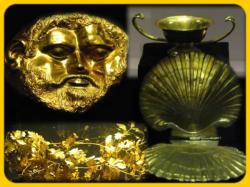|
| EconMin: Bulgaria's Top Thracian Treasure Will Boost Investment |
|
|
 High-ranking Bulgarian statespersons attended Monday the first-ever display of the world famous Panagyurishte Thracian Treasure in the town near which it was found.
High-ranking Bulgarian statespersons attended Monday the first-ever display of the world famous Panagyurishte Thracian Treasure in the town near which it was found.
The treasure was uncovered by three local brothers near central Bulgarian town of Panagyurishte in 1949, and has since made world renown as one of the top works of art of the Thracian civilization.
"Today's return of the treasure to Panagyurishte is an investment in our nation's self-esteem. It is certain to draw in interest," stated Bulgarian Minister of Economy, Energy and Tourism Delyan Dobrev at the official event.
The Panagyurishte History Museum built a special safety display room, where the treasure will be on exhibit through May 16.
Bulgarian Minister of Interior Tsvetan Tsvetanov, who was also present at the event, said that all security measures had been taken for the storage of the gold pieces in Panagyurishte.
It has been decided that in the future the treasure, which is owned by Bulgaria's National History Museum in capital Sofia and is usually on travelling exhibits around the globe, will stay for a month in Panagyurishte each year.
"I want to especially thank Bulgarian Minister of Culture Vezhdi Rashidov for making this happen," commented Panagyurishte History Museum Director Georgi Abdulov.
He also said that two replicas of the Thracian treasure are set to be made in pure gold, to be donated to the National History Museum in Sofia and the Panagyurishte History Museum.
Bulgaria's Vice-President Margarita Popova, a number of MPs, as well as historian and ex-minister Bozhidar Dimitrov were also present at the official unveiling of the exhibit in Panagyurishte Monday.
The Panagyurishte Gold Treasure was found on December 8, 1949, by three brothers – Pavel, Petko and Michail Deikovi, who worked together at the region of Merul tile factory near the town of Panagyurishte, Bulgaria.
It consists of a phial, an amphora and seven rhytons with total weight of 6.164 kg of 23-karat gold. All of the objects are richly and skilfully decorated with scenes from Thracian mythology, customs and life.
It is dated to the 4th-3rd centuries BC, and is thought to have been used as a royal ceremonial set by the Thracian king Seuthes III.
http://novinite.com |
| Tuesday, Apr 17, 2012 |
|
|
|
|
| » RENTALS |

|
|
|
| Shop / Retail |
€ 460 |
|
| Location: |
Veliko Tarnovo |
|
|

|